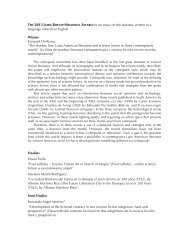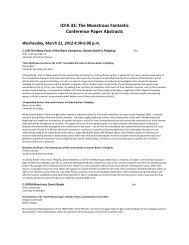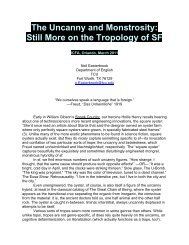underreading the narratives and their implications. Nor should we try to automatically reconstruct them as “secret” feminist texts. Instead weneed to carefully explore their complex position within the contexts of contemporary discourses.*******Thursday, March 22, 2012 4:00-5:30 p.m.42. (SF) <strong>Monstrous</strong> Posthuman Imaginings PineChair: Gerry CanavanDuke University<strong>The</strong> <strong>Monstrous</strong> Future: Freedom and the Posthuman Age in Scott Westerfeld’s Uglies TrilogyRobert GadowskiUniversity of Wrocław<strong>The</strong> figure of the monster is universally recognized as a powerful cultural metaphor. Most scholars believe that the monster is not a meresignifier of the other, alien qualities, but rather performs the role of an avatar of humanity’s own anxieties and potentials. Significantly, asJeffrey Jerome Cohen emphasizes in his 1996 book Monster <strong>The</strong>ory: Reading Culture, “[m]onster notoriously appears at times of crisis as a kindof third term that problematizes the clash of extremes” (6). In this day and age humankind stands at the threshold of technologically mediatedtransformation from human to posthuman—a clash of two extremes bringing unprecedented consequences. Much as the monster, theposthuman belongs to a “break category” (Cohen x), a condition that has to be defined in order to be understood and then either embraced ordeplored. Such considerations are strongly present in popular culture, particularly in science fiction. In this paper I argue that ScottWesterfeld’s <strong>The</strong> Uglies trilogy can be seen as a narrative that sets a new paradigm for the argument that the posthuman condition and valuesit entails have yet to be determined. Informed by Cohen’s theories and by such penetrating approaches to the monster and the posthuman aspresented by Elaine L. Graham, Francis Fukuyama and Chris Hables Gray and others, my paper aims to reflect upon <strong>The</strong> Uglies trilogy as animportant narrative commenting on the possibilities of becoming posthuman.A Cancer in the Body Polity: Terrorism and Monstrosity in the Post-Human Novels of Neal AsherStan Hunter Kranc<strong>The</strong> Pennsylvania State University<strong>The</strong> thematic underpinning of much of science fiction is the conflict between protagonists and “monsters.” <strong>The</strong> works of British science fictionauthor Neal Asher problematize this conflict: in a post-human world, where form, identity, and even mind can be whimsically fluid, what trulycan be considered “monstrous”? Asher posits a near future civilization ruled by an oligarchy of all-seeing, all-powerful artificial intelligences.But, as seen through the eyes of characters human, machine, and something in between, Asher asks readers to imagine this government not asa dystopic and inhuman technocracy, but rather as a kind of post-human utopia, whose citizens have lost privacy and self government butgained economic freedom and security. Of course, the peace of Asher’s Polity universe is threatened by enemies both internal and external.<strong>The</strong> struggles of Ian Cormac, a human secret agent “gridlinked” to the AI rulers forms the unifying narrative of the series. This paper proposes arhetorical reading of these novels, focusing on the construction of a fundamentally moralistic conflict between Agent Cormac and themonstrous foes of the Polity. However, as both protagonists and antagonists are able to “reshape” their bodies and minds, readers are robbedof the traditional signifiers in identifying heroes and villains.Popping the Bubble of the Metaverse: Posthuman Control in Neal Stephenson’s Snow CrashMonica SedoreFlorida Atlantic UniversityNeal Stephenson’s third novel, Snow Crash, is one of the most popular works of cyberpunk science fiction. Though the novel was published in1992, several years before the Internet became a necessary tool in the late 90s, it still offers an eerie prologue to the world of technology usedby individuals in the twenty-first century. <strong>The</strong> main component of Stephenson’s novel is the Metaverse, a “computer-generated universe,” (24)into which one may be “goggled in” at any place, any time. My argument centers on the idea that in the Metaverse, the more freedom thecharacters believe they have achieved, the more control is actually exerted upon them. <strong>The</strong> two theoretical texts I will be relying on (andsubsequently merging) to frame my argument are Michel Foucault’s Discipline and Punish and N. Katherine Hayles’s How We BecamePosthuman: Virtual Bodies in Cybernetics, Literature, and Informatics. <strong>The</strong> setting of Snow Crash is both a carceral system and a posthumanworld. <strong>The</strong> Metaverse gives the characters their perceived freedom in the posthuman world, but the carceral system is what keeps them lockeddown.
44. (CYA) <strong>The</strong> Monstrosity of Teenage Girls MapleChair: Kendra HolmesUniversity of Florida<strong>The</strong> <strong>Monstrous</strong> Feminine and Signifying Other: Gorgons, New Women, and Neo-Victorian LiteratureMandy MahaffeyUniversity of Central FloridaOriginally stemming from the idea of the female grotesque and the carnivalesque nature of Libba Bray’s Gemma Doyle Trilogy outlined in myprevious paper for ICFA 32, this paper will examine [O]ther monsters, both literal and metaphorical, through teasing out complexities of theGorgon and Felicity in their paralleled and converging storylines of selfhood. It is the juxtaposition between and confusion of [self-]denial and[self-]acceptance, “real” and mythological, hidden and exposed, and inner- and outer-lives that I am most interested in presently. BecauseFelicity exists, for the most part, in a phallogcentric culture, her need to communicate her Self is different from the Gorgon’s need. Both,however, are steeped within particulars of language, coding themselves according to what they think the hegemonic order and respective subsectrequires as well as creating their own language of existence for, by, and in regard to their Self---simultaneously denying and nurturing asort of joissance. At the heart of my paper lies paradox, leading me to likely draw from earlier structuralist (feminist and otherwise) thought aswell as later poststructuralist and postmodern (queer and otherwise) thought. Cixous’ often troubling and amply criticized Laugh of the Medusamight be quoted in brief to question the dynamics of a simultaneously parallel and perpendicular storyline of Self and Other. Though criticsfrequently fault Cixous for essentializing Woman and idealizing maternity, Medusa offers an interesting imperative to write the body---perhapsone that can be further explained, dismantled, or rebuilt in my close reading of the Trilogy. Ultimately, I wish to examine how neo-Victorian CYAliterature like Bray’s Trilogy conceptualizes, defines, and manifests historical and contemporary roles of the feminine and femininity to thereading child.Justine Larbalestier’s Werewolf Liar: Why Teenage Girls Are ScaryTamar DitzianUniversity of FloridaIntegral to at least five of Jeffrey Jerome Cohen’s seven theses on monstrosity are borders and the threat of their breakdown. Monsters tend tovex culturally important categorical distinctions: living/dead, substantial/insubstantial, human/animal, domestic/alien, etc. Thus, Cohen’s thirdthesis, that “the monster is the harbinger of category crisis” might be usefully understood as central to understanding monstrosity as areflection of cultural concerns over identity. This minor theoretical shift helps in analyzing the categorical dissolutions being signaled throughparticular monstrous bodies. That what is most monstrous might in fact be what is least definable, and nothing more sinister than that, haspowerful and disturbing ramifications in identity politics. In her young adult novel, Liar, Justine Larbalestier engages in such discourse inintroducing us to Micah, a biracial, bisexual, boyish, adolescent girl. What complicates the text is that the story is told through an unreliable firstperson narration in which Micah is only clearly honest with us about one thing: she is a pathological liar. Two aspects of the text embody what Iargue is its underlying monstrosity: Micah’s assertion that she is a werewolf and the novel’s lack of closure about this as well as all of Micah’sother assertions. In this paper, I argue that the monstrosity of the textual body itself, as well as that of the teenage body it purports toillustrate, reflects our cultural fears both about the breakdown of the imagined borders between girl, boy, straight, gay, black, white, adult,child, human, animal, etc, and about the unknowable “truth” of an existence which straddles such categorical boundaries. Both the novel’sunknowability and Micah’s understanding of herself as something monstrous, liminal, and thus unknowable, contribute to the novel’sillustration of the imagined monstrosity of adolescent girls. Because Micah, not unlike many teenage girls, struggles to identify with culturallyconceivable identities—fictional or not—her story highlights the contingency and contestability of the way in which we define ourselves.<strong>The</strong> Last Human Monster: Power, Sexuality, and Embodiment in Kristin Cashore’s FireMeghann MeeusenIllinois State UniversityDepictions of monstrosity have flourished in recent adolescent literature, with stories of vampires, werewolves, zombies and demons flyingfrom the shelves as quickly as they can be marketed. As scholars like Jeffrey Cohen have posited, such monsters often reflect cultural anxieties,and Kristin Cashore’s Fire offers no exception. Cashore develops a compelling monster heroine who seeks redemption for the horrors hertyrannical father committed, providing commentary on feminine sexuality, embodiment and power in a characterization of the last humanmonster. In Cashore’s mythic realm, each species has a stunningly beautiful and powerful “monster” equivalent, including the text’s femaleprotagonist, Fire. Human monsters can control what others think, a trait Fire’s father manipulates until she feels forced to orchestrate hisdeath, a secret she believes solidifies her a monster. Still, despite her attempts to embrace humanity and reject her monstrous characteristics,she cannot control the physical effect of her beauty. Fire’s incredible sexual allure frequently places her in profound danger, so that herhappiness and safety depends on not only her own mental discipline, but on the human men in her life who are often lost to lust, becoming farmore monstrous than she. My presentation considers how Cashore uses these aspects of monstrosity to complicate constructed identity,accentuating the complexity of a mind/body binary in gendered power relationships. Furthermore, my study explores the ways Fire’s instinctualcharacteristics connect to her beauty and tie sexuality to monstrosity, problematizing the humanity/animality distinction that definescharacters as monsters, humans and gendered individuals. Cashore’s text prompts questioning of whether Fire can or should control thosemonstrous parts of herself, why she needs to, and what cultural anxieties they represent. My presentation investigates these questions,seeking to articulate what it means to be a monster in both fiction and society.
- Page 4 and 5: 5. (F) Wondrous Bodies of the Gende
- Page 6 and 7: Fantastic Suicide: Reading the Unca
- Page 8: Viral Posthumanism: Boundaries and
- Page 11 and 12: The Concept of Soul Divisibility in
- Page 13 and 14: Thursday, March 22, 2012 10:30 a.m.
- Page 15 and 16: 21. (CYA) Terrifying Futures: Post-
- Page 17 and 18: 23. (FTV/H) Now I’m Feelin’ Zom
- Page 19 and 20: Fight Club: Amalgam of the Horrific
- Page 21 and 22: Taking the Monsters out of the Clos
- Page 23: Kaspar J. SaxenaIndependent Scholar
- Page 27 and 28: 46. (FTV/SF) Monstrous Spin-offs: T
- Page 29 and 30: 49. (F) Aspects of Miéville Captiv
- Page 31 and 32: 53. (SF) War and Crisis in 1940s an
- Page 33 and 34: Abuse of Power: An Evolutionary Res
- Page 35 and 36: Disappearing Natives: The Colonized
- Page 37 and 38: 60. (H/IF) Ancient and Medieval Mon
- Page 39 and 40: 62. (F) The Works of Tolkien Captiv
- Page 41 and 42: 67. (SF) Imperial and Postcolonial
- Page 43 and 44: Beheading the Gorgon: Beautifying C
- Page 45 and 46: 71. (VPA) Monstrous Music MagnoliaC
- Page 47 and 48: 73. (F/IF) Portraying New Worlds Ca
- Page 49 and 50: Friday, March 23, 2012 2:45-3:45 pm
- Page 51 and 52: 81. (FTV) Those Damn Dirty Apes! Cy
- Page 53 and 54: Friday, March 23, 2012 4:00-5:30 pm
- Page 55 and 56: 92. (F) Leaving the Demonized Other
- Page 57 and 58: 94. (FTV/CYA) Monstrosity and Devia
- Page 59 and 60: of cannibalism, ghostly seduction i
- Page 61 and 62: Saturday March 24, 2012 8:30-10:00
- Page 63 and 64: 104. (CYA) Classic Monsters, Reinte
- Page 65 and 66: 107. (VPA) Monstrous Gaming Bodies
- Page 67 and 68: who challenge the order that the Br
- Page 69 and 70: Reading Between the Times: A Critic
- Page 71 and 72: 117. (FTV) Monsters and Superheroes
- Page 73 and 74: 119. (IF/H/PCS) International Mash-
- Page 75 and 76:
Focusing on Stoker's Dracula as one
- Page 77 and 78:
Florida Atlantic UniversitySheri S.
- Page 79 and 80:
Simmons CollegeIn the spate of rece
- Page 81 and 82:
Independent ScholarKing’s story
- Page 83 and 84:
modernity opens up for every indivi
- Page 85 and 86:
Saturday March 24, 2012 4:00-5:30 p
- Page 87 and 88:
141. (FTV) Monstrous Masculinity Cy
- Page 89 and 90:
ultimately make peace with her mons
- Page 91 and 92:
where the almost-human sentient zom





